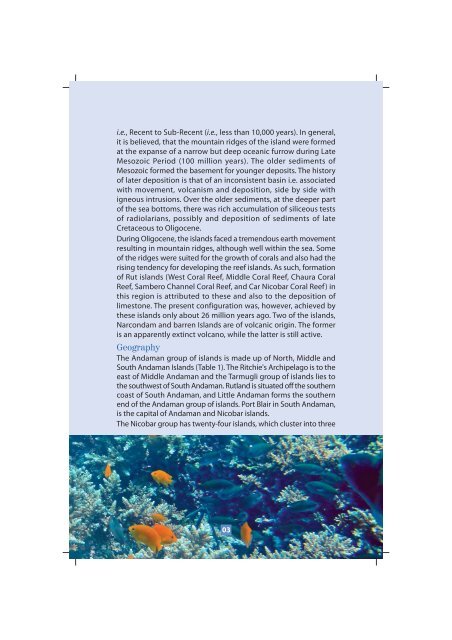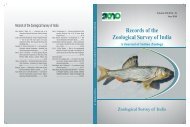Andaman booklet aw.FH10 - Zoological Survey of India
Andaman booklet aw.FH10 - Zoological Survey of India
Andaman booklet aw.FH10 - Zoological Survey of India
You also want an ePaper? Increase the reach of your titles
YUMPU automatically turns print PDFs into web optimized ePapers that Google loves.
i.e., Recent to Sub-Recent (i.e., less than 10,000 years). In general,<br />
it is believed, that the mountain ridges <strong>of</strong> the island were formed<br />
at the expanse <strong>of</strong> a narrow but deep oceanic furrow during Late<br />
Mesozoic Period (100 million years). The older sediments <strong>of</strong><br />
Mesozoic formed the basement for younger deposits. The history<br />
<strong>of</strong> later deposition is that <strong>of</strong> an inconsistent basin i.e. associated<br />
with movement, volcanism and deposition, side by side with<br />
igneous intrusions. Over the older sediments, at the deeper part<br />
<strong>of</strong> the sea bottoms, there was rich accumulation <strong>of</strong> siliceous tests<br />
<strong>of</strong> radiolarians, possibly and deposition <strong>of</strong> sediments <strong>of</strong> late<br />
Cretaceous to Oligocene.<br />
During Oligocene, the islands faced a tremendous earth movement<br />
resulting in mountain ridges, although well within the sea. Some<br />
<strong>of</strong> the ridges were suited for the growth <strong>of</strong> corals and also had the<br />
rising tendency for developing the reef islands. As such, formation<br />
<strong>of</strong> Rut islands (West Coral Reef, Middle Coral Reef, Chaura Coral<br />
Reef, Sambero Channel Coral Reef, and Car Nicobar Coral Reef) in<br />
this region is attributed to these and also to the deposition <strong>of</strong><br />
limestone. The present configuration was, however, achieved by<br />
these islands only about 26 million years ago. Two <strong>of</strong> the islands,<br />
Narcondam and barren Islands are <strong>of</strong> volcanic origin. The former<br />
is an apparently extinct volcano, while the latter is still active.<br />
Geography<br />
The <strong>Andaman</strong> group <strong>of</strong> islands is made up <strong>of</strong> North, Middle and<br />
South <strong>Andaman</strong> Islands (Table 1). The Ritchie's Archipelago is to the<br />
east <strong>of</strong> Middle <strong>Andaman</strong> and the Tarmugli group <strong>of</strong> islands lies to<br />
the southwest <strong>of</strong> South <strong>Andaman</strong>. Rutland is situated <strong>of</strong>f the southern<br />
coast <strong>of</strong> South <strong>Andaman</strong>, and Little <strong>Andaman</strong> forms the southern<br />
end <strong>of</strong> the <strong>Andaman</strong> group <strong>of</strong> islands. Port Blair in South <strong>Andaman</strong>,<br />
is the capital <strong>of</strong> <strong>Andaman</strong> and Nicobar islands.<br />
The Nicobar group has twenty-four islands, which cluster into three<br />
03
















